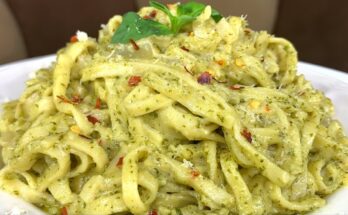Best Chicken and Rice Recipe: Let’s talk about comfort food. You know, the kind that warms your soul and makes you feel at home with just one bite? Chicken and rice is that dish. Whether you’re recovering from a long day or feeding a family of five, this recipe fits the bill perfectly. Simple yet hearty, it’s one of those meals that has stood the test of time—and for good reason.
What makes this dish so special? It’s the way the juicy chicken blends with the soft, fluffy rice. The savory aroma that fills your kitchen. The nostalgic feel of home-cooked goodness. You’ll find variations of this recipe in nearly every culture, from Latin American arroz con pollo to Middle Eastern chicken mandi.
But here’s the thing—getting it just right isn’t as simple as tossing everything into a pot. That’s why this step-by-step guide exists. I’ll walk you through the process of creating a deeply flavorful, absolutely satisfying chicken and rice dish that’s perfect every time. And yes, this version is both weeknight-friendly and impressive enough for guests. Ready? Let’s cook!
Why Chicken and Rice Is a Global Favorite
Think about it: what do countries like Spain, India, China, and Mexico all have in common? A version of chicken and rice that’s beloved by their people. It’s the ultimate comfort food that adapts to flavors, spices, and techniques of different regions.
In Spain, you get saffron-infused paella with seafood and chicken. In India, it’s the aromatic biryani with layers of spiced rice and marinated chicken. Latin America gives us arroz con pollo, vibrant with cumin and peppers. Even American kitchens have their own cozy casserole versions with cheddar and creamy sauces.
Why does this combo work so well everywhere? It’s because chicken and rice both act like flavor sponges. They absorb whatever seasoning, broth, or sauce you throw at them. And together, they make a meal that’s filling, nutritious, and budget-friendly.
This global appeal is another reason to master the basic recipe. Once you do, you can start experimenting with different regional twists, and turn one recipe into many.
Benefits of Making Chicken and Rice at Home
Sure, takeout is tempting. But making chicken and rice at home comes with some serious perks. First of all, it’s healthier. You control the salt, the fat, and the portion sizes. No mystery ingredients or unnecessary additives—just good, clean food.
Then there’s the cost. Buying a whole chicken and some rice can feed an entire family for a fraction of what you’d spend at a restaurant. And leftovers? Oh yes, this dish tastes even better the next day, making it perfect for meal prep.
Lastly, cooking this dish gives you the chance to bond with the process. There’s something really satisfying about turning basic ingredients into something extraordinary. You get to stir the pot, smell the spices, and feel that moment when everything starts to come together.
It’s kitchen therapy at its best—delicious, grounding, and incredibly rewarding.
Ingredients Needed for the Perfect Chicken and Rice
Let’s get down to business—ingredients. The beauty of this dish lies in its simplicity. But don’t mistake that for blandness. The secret lies in using fresh, quality ingredients and knowing how to layer flavor.
Fresh Ingredients You’ll Need
Here’s a classic lineup:
- Chicken – Bone-in, skin-on thighs or drumsticks bring the most flavor. You can also use boneless, but you might miss out on that rich taste.
- Long grain white rice – It stays fluffy and doesn’t get too sticky.
- Onion – Diced for a flavor base.
- Garlic – Lots of it! Freshly minced for that pungent kick.
- Chicken broth – This is where your rice gets its taste.
- Bell pepper – Optional but adds color and sweetness.
- Tomato paste or fresh tomatoes – For depth and a little tang.
- Olive oil or butter – For sautéing and adding richness.
- Salt and pepper – Basic seasoning but essential.
- Cumin, paprika, and turmeric – These add earthiness and color.
- Bay leaves – Just one or two for an herbal note.
You can always tailor this list to what you have on hand, but these basics are a solid starting point.
Optional Add-ins for Extra Flavor
Want to take it up a notch? Here are some game-changing add-ins:
- Chopped cilantro or parsley – Adds a fresh, herby finish.
- Lemon juice or zest – Brightens everything up.
- Peas or corn – For extra color and texture.
- Chili flakes or fresh jalapeños – If you like heat.
- Parmesan or feta – For a cheesy twist.
These ingredients aren’t necessary, but they give you the freedom to customize. Think of the base recipe as your canvas—these extras are your paint.
Step-by-Step Instructions
Now that your ingredients are ready, it’s time to bring everything together. Follow these steps carefully, and you’ll end up with a chicken and rice dish that’s both flavorful and foolproof.
Step 1: Prepping the Chicken
Before anything else, give your chicken a good rinse under cold water and pat it dry with paper towels. This helps the skin crisp up when you sear it. Next, season the chicken generously with salt, pepper, and a sprinkle of your chosen spices—paprika, cumin, turmeric, and even a pinch of chili powder if you like a kick.
If you have time, let the chicken sit with the seasoning for 30 minutes to an hour. Marination makes a huge difference—it helps the spices seep into the meat for a more flavorful bite.
Heat a heavy-bottomed skillet or Dutch oven over medium-high heat and add olive oil or butter. Sear the chicken skin-side down first until it’s golden brown and slightly crispy, usually about 5-7 minutes per side. You’re not cooking it through at this stage, just building that beautiful crust and sealing in the juices.
Once browned, remove the chicken and set it aside. You’ll return it to the pot later, but right now, it’s time to build the flavor base.
Step 2: Sautéing the Aromatics
Now, in the same pot (don’t clean it out—you want those tasty browned bits), reduce the heat to medium. Add a little more oil if needed, and toss in your chopped onions. Stir and sauté until they’re soft and translucent, about 5 minutes.
Next comes the garlic—freshly minced and fragrant. Toss it in and stir continuously to keep it from burning. If you’re using bell peppers or tomatoes, now’s the time to add them. Cook everything together until the tomatoes break down and the peppers soften, infusing the mixture with rich, deep flavor.
You’ll notice the bottom of the pot developing a golden layer—that’s where the magic is. Deglaze it by pouring in a splash of chicken broth and scraping up those browned bits with a wooden spoon. That’s pure flavor gold right there.
Step 3: Cooking the Rice with Chicken Broth
Once your aromatics are cooked down and fragrant, it’s time to introduce the rice. Add your long-grain rice directly into the pot with the sautéed veggies and spices. Stir it around for a few minutes to toast it slightly. This simple step helps the rice soak up more flavor and gives it a nutty aroma.
Now, pour in the chicken broth. The ratio is typically 2 parts liquid to 1 part rice, but check your rice package for specific guidance. You want the rice fully submerged with about an inch of broth covering it.
Season the broth lightly with salt, pepper, and maybe another sprinkle of your spices. Toss in your bay leaves and give it all a good stir. Let the broth come to a gentle boil, then reduce the heat to low.
Step 4: Simmering the Chicken and Rice Together
Here’s where it all comes together. Nestle the seared chicken pieces back into the pot, skin-side up. The broth should just cover the rice while the chicken sits comfortably on top.
Cover the pot with a tight-fitting lid and let everything simmer for about 25–30 minutes. No peeking! Keeping the lid closed ensures all the steam stays trapped, which helps cook the rice perfectly.
After 30 minutes, lift the lid and check the rice for doneness. It should be tender, fluffy, and infused with all those rich flavors from the broth and aromatics. The chicken should be cooked through, juicy, and easy to pull apart with a fork.
If the rice isn’t quite done but the liquid is absorbed, you can add a splash more broth and continue cooking for another 5-10 minutes.
Step 5: Final Touches and Garnishing
Once your chicken and rice are cooked to perfection, it’s time for the finishing touches. Remove the pot from heat and let it sit, covered, for about 5 minutes. This rest period helps the flavors settle and gives the rice time to absorb any remaining moisture.
Remove the bay leaves and fluff the rice gently with a fork. Taste and adjust seasoning if needed—maybe a pinch more salt or a squeeze of lemon juice.
Now, sprinkle your dish with freshly chopped parsley or cilantro for a burst of color and freshness. If you’re going for a little extra flair, top it off with some crumbled feta or a handful of peas.
Serve it hot, straight from the pot, with a side salad, roasted veggies, or just a spoon. It’s that good.
Tips and Tricks for the Best Chicken and Rice
Great chicken and rice isn’t just about following a recipe—it’s about the little touches that take it to the next level. Here are a few insider tips:
- Toast the rice before adding the broth. It deepens the flavor.
- Use homemade chicken stock if you can—it’s richer and more flavorful.
- Let the chicken rest before serving so the juices redistribute.
- Taste and adjust seasonings at the end—you’re the chef!
How to Make It More Flavorful
Even though the basic chicken and rice recipe is already packed with flavor, there are always ways to enhance it further. Let’s talk about layering flavor, which is a technique used by top chefs and home cooks alike.
Start with the chicken itself. Marinate it if you have time. A quick marinade of yogurt, lemon juice, garlic, and spices can work wonders for tenderness and depth of flavor. Even 30 minutes makes a big difference.
Then comes the broth—use a good-quality chicken stock or make your own if possible. Store-bought broth works in a pinch, but homemade gives your rice a richer, deeper taste. You can simmer chicken bones with carrots, celery, onions, bay leaves, and garlic for a few hours for the best results.
Aromatics are your best friend. Don’t skimp on the onions, garlic, and herbs. Adding a pinch of saffron or smoked paprika brings a whole new level of complexity. Want even more depth? A splash of soy sauce or Worcestershire can provide that umami kick.
Don’t underestimate the power of fresh herbs. Garnishing with chopped cilantro, parsley, or green onions at the end adds brightness and contrast to the rich, savory dish. And don’t forget a squeeze of lemon or lime just before serving—it balances everything out and makes the flavors pop.
Common Mistakes to Avoid
Even the simplest recipes can go wrong if you’re not careful. Let’s go over the most common chicken and rice pitfalls—and how to avoid them.
1. Overcooking the rice: This is the number one mistake. Rice should be tender and fluffy, not mushy. Stick to the recommended liquid-to-rice ratio and avoid lifting the lid during cooking. Every time you open it, you let steam escape and mess with the cooking time.
2. Using boneless, skinless chicken: While convenient, it doesn’t pack the same flavor as bone-in, skin-on pieces. The bones enrich the broth, and the skin crisps up beautifully during searing.
3. Not searing the chicken first: This step isn’t optional. Searing locks in moisture and builds that irresistible golden crust, which contributes tons of flavor to the whole dish.
4. Rushing the aromatics: Don’t dump everything in at once and expect greatness. Take the time to properly sauté your onions, garlic, and tomatoes. That slow cook builds a flavor base that elevates the entire dish.
5. Skipping the rest time: Letting the dish sit for five minutes after cooking helps the rice finish steaming and allows the flavors to meld. It’s worth the wait.
Avoiding these missteps will give you a consistently great chicken and rice dish every single time.
FAQs About Chicken and Rice Recipes
Q1: Can I use brown rice instead of white rice?
Yes, but remember that brown rice takes longer to cook and requires more liquid. Adjust your broth and cooking time accordingly.
Q2: Is it okay to use boneless chicken?
Absolutely. While bone-in adds more flavor, boneless chicken thighs or breasts work fine. Just reduce cooking time so it doesn’t dry out.
Q3: How do I store and reheat leftovers?
Let the dish cool, then store it in an airtight container in the fridge for up to 4 days. Reheat gently on the stove or microwave with a splash of broth.
Q4: Can I make this dish in a rice cooker or Instant Pot?
Yes! Sear the chicken separately and follow your appliance’s instructions for rice and broth ratios. It’s quicker and still delicious.
Q5: What’s the best side dish for chicken and rice?
A simple green salad, sautéed veggies, or roasted root vegetables pair wonderfully. For something heartier, try warm pita or garlic bread.
Conclusion
What sets this dish apart is its adaptability. You can tweak the spices, toss in different veggies, or add unexpected ingredients to make it truly your own. But even in its most basic form, it delivers big on taste and comfort.
Whether you’re feeding your family, prepping meals for the week, or just craving something cozy and homemade, this recipe has you covered. It’s simple, versatile, and always hits the spot.
So the next time you’re not sure what to cook, remember this guide. With a few basic ingredients and some kitchen love, you’ll have a dish that’s not only delicious but also deeply satisfying.



